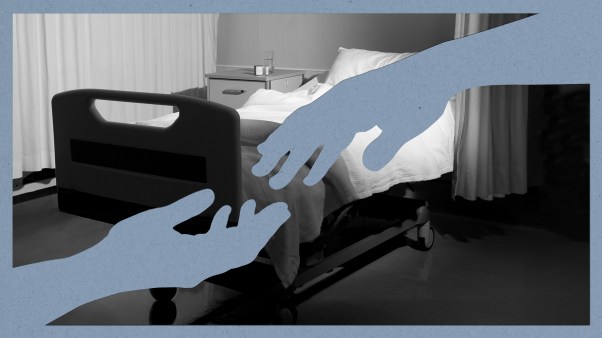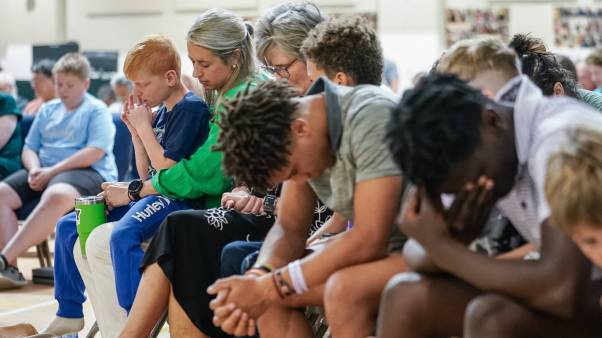As a pastor serving a local church near my alma mater, Michigan State, I was invited to stand at a listening post along with comfort dogs the day after last month’s shooting.
Campus was unnervingly empty as yellow barricade tape flapped in the breeze, restricting our access to the buildings. Clusters of candles marked where each of the three victims had died—while a lone undergraduate student ran back and forth with a lighter trying, hopelessly, to keep them all lit.
Although campus was devoid of students, it was thronging with media crews and reporters. Everyone who was usually on campus had gone home to mourn, while those from outside had come in to gaze at us through their camera lenses and television screens—inviting the public eye to witness private moments of pain and hurt in our community.
A similar spectacle is playing out right now at the Covenant Christian School in Nashville, Tennessee—as it has at schools in Uvalde, Texas; Oxford, Michigan; and MSU. And the same scene will play out at the next mass shooting, an occurrence that seems mercilessly inevitable.
There is something real and peculiar about the human fascination with looking at pain and hurt, crisis and tragedy. For centuries, people have made pilgrimages to the theater to watch Hamlet hold up a skull or to see the misfortunes that befell Desdemona, Emilia, Roderigo, and Othello. More commonly, the highway becomes a stage whenever traffic slows to stare at a car accident.
Tragedy is magnetizing. And yet, it can also be healing. In times of personal pain and hurt, I have found solace in religious art depicting tragedy. It has helped me contemplate the raw pain of human life.
 WikiMedia Commons / Pexels / Edits by CT
WikiMedia Commons / Pexels / Edits by CTWhen my wife and I experienced multiple miscarriages, William-Adolphe Bouguereau’s painting The First Mourning became meaningful to me in the midst of crisis. The work of art depicts Adam clutching at his rib while his murdered son, Abel, is lifelessly sprawled across his lap. Eve, the boy’s mother, is unable to look as she hides in Adam’s embrace.
It is a visceral and arresting image, evoking a pain that the artist knew well—as four of Bouguereau’s five children had died before him. And today, the same root of sin that caused Cain to kill Abel continues to bring death to our children in school shootings.
Religious art can help us see in times of tragedy far better than the horror shows depicted by modern media—which, if we are not cautious, can leave us callous to pain and hurt.
In his book Only the Lover Sings, German Catholic philosopher Josef Pieper suggests that we are blinded by the visual noise of contemporary life. When there is so much to see, our sight can become shallow or incapacitated. Pieper puts it like this: “We do not mean here, of course, the physiological sensitivity of the human eye. We mean the spiritual capacity to perceive the visible reality as it truly is.”
Because of modern technology, we can see more today than ever before. But, curiously and conversely, this can inhibit our ability to see beyond the surface. To borrow an image from Nicholas Carr in his book The Shallows, we are like Jet Skiers bouncing across the water instead of deep-sea divers who patiently venture below into matters of substance.
Pieper warns that something is lost when all we do is glance but never gaze: “Going below a certain bottom line quite obviously will endanger the integrity of man as a spiritual being. It seems that nowadays we have arrived at this bottom line.” These words are even more prescient today than in Pieper’s time—before the age of social media, smartphones, and school shootings.
The antidote for living in a world of visual noise and occluded seeing is, according to Pieper, creating and viewing works of art. Artists as well as viewers of art linger over the intricacies of human life—including all of its pain and hurt. The unhurried gaze and leisurely lingering over a work of art provides room for reflection, insight, and healing.
Pieper suggests that viewing art fosters “a deeper and more receptive vision, a more intense awareness, a sharper and more discerning understanding, a more patient openness for all things quiet and inconspicuous, an eye for things previously overlooked.”
 WikiMedia Commons / Pexels / Edits by CT
WikiMedia Commons / Pexels / Edits by CTAlong with William-Adolphe Bouguereau, I often reflect on the work of Michelangelo Merisi da Caravaggio. The 19th-century art critic John Ruskin once described Caravaggio’s work as being marked by vulgarity and impiety. Ruskin said that Caravaggio’s paintings revealed “horror and ugliness, and filthiness of sin.” While Ruskin meant that as a critique of Caravaggio, I think it is what makes his work so meaningful.
For example, Caravaggio’s The Entombment of Christ depicts the lifeless Jesus being carried by Nicodemus and John the Evangelist. Meanwhile, three women—Mary of Cleophas, Mary Magdalene, and Mary the mother of Jesus—mourn in their own particular ways. One looks at the dead body of Jesus, one cries, and one cries out to heaven.
Just as Ruskin said, this painting shows the full horror, ugliness, and filthiness of the sin that led to Jesus dying on the cross. It is also worth noting that Caravaggio scandalized people in his day by using human models from off the street for his paintings. The hurting people in this painting may very well have been students, laborers, mothers, or drifters.
Caravaggio’s painting of the entombment of Christ is in the chapel of the Pieta in St. Peter’s Basilica in Vatican City. In that very same space, Michelangelo’s Pietá sculpture depicts Mary (a very iconic figure in religious art) holding a lifeless Jesus sprawled across her lap. Jesus rests across the lap of Mary in the very same pose as Abel resting across the lap of Adam in Bouguereau’s The First Mourning.
These three works of art help us see a coherent narrative amid the incoherence of endless school shootings: the pain and hurt of sin finds a horizon of healing in Jesus and the empty tomb of Easter.
A. Trevor Sutton is a Lutheran pastor in Lansing, Michigan, and the author of two books: Redeeming Technology: A Christian Approach to Healthy Digital Habits and Clearly Christian: Following Jesus in This Age of Confusion.











